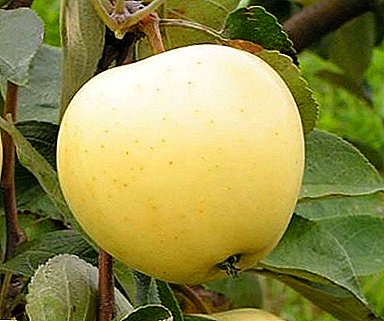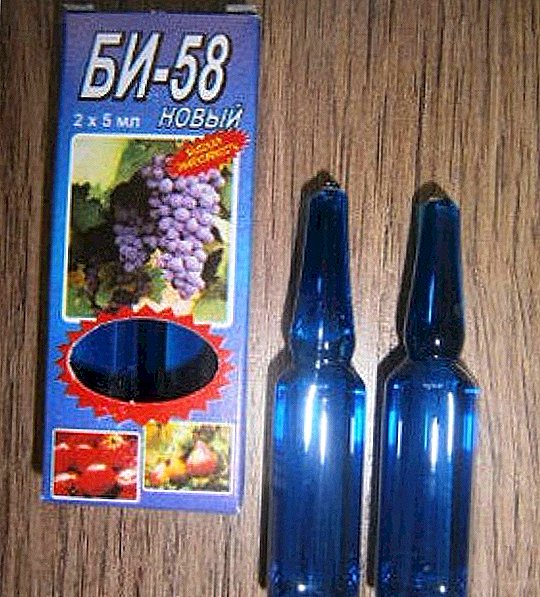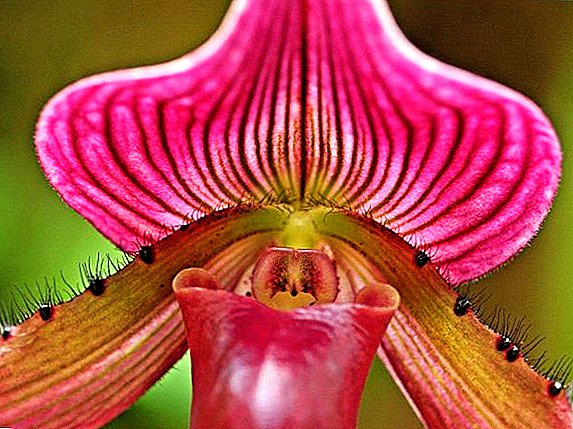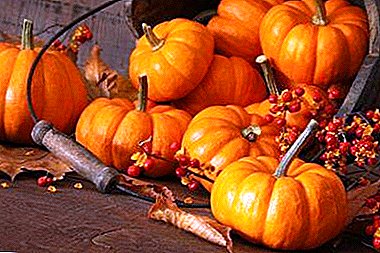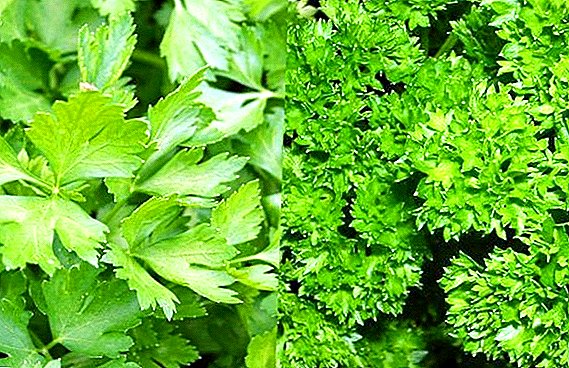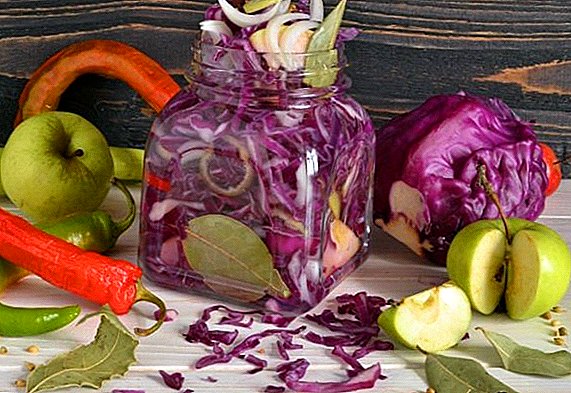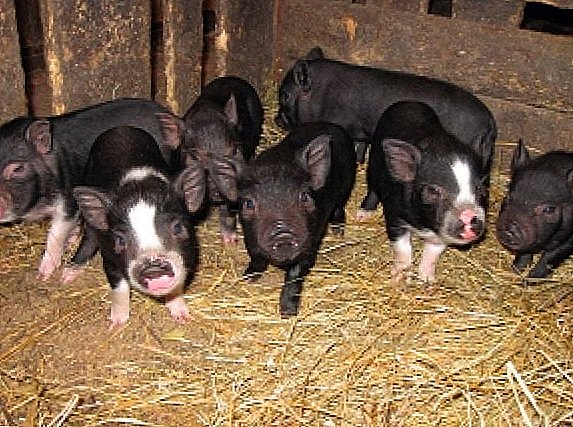 The guinea fowl as an agricultural bird is much less common than the chicken, although it is its close relative. Nevertheless, the domestication of this bird began from time immemorial. It is not surprising that during this time, a man derived a huge number of its various breeds, and this work is constantly ongoing. One of these new breeds of domestic breeding is the Siberian white guinea fowl.
The guinea fowl as an agricultural bird is much less common than the chicken, although it is its close relative. Nevertheless, the domestication of this bird began from time immemorial. It is not surprising that during this time, a man derived a huge number of its various breeds, and this work is constantly ongoing. One of these new breeds of domestic breeding is the Siberian white guinea fowl.
History of origin
As the name of the breed suggests, Siberia is the birthplace of the bird. To be more precise - the city of Omsk. Moreover, the breed was caused by very specific reasons.
The fact is that in Russia, guinea fowls were historically considered as decorative birds, it was not accepted to use their meat for food, including because of the dark color of the carcass, which is unusual for our mentality. In addition, in the egg production, guinea fowls were much inferior to chickens, which made their agricultural breeding unprofitable.
Did you know? In ancient Greece guinea fowl were considered sacred birds and heralds of the goddess of hunting and fertility of Artemis. According to one of the legends, the goddess turned the sisters Meleagra into kesarok, who killed the evil boar first, whom Artemis sent to people in retaliation for the sacrifice not brought to her, and then, not wanting to share with others the glory of a winner, even her own uncle. The silver plumage of hens was associated among the Greeks with the tears of young girls.
After the Second World War, 4 scientific institutes were immediately engaged in resolving questions about the breeding of guinea fowls in the Soviet Union:
- general genetics of the USSR Academy of Sciences;
- Siberian Research Institute of Agriculture (Omsk);
- Siberian Scientific and Technical Institute and Design and Technological Institute of Livestock (Novosibirsk);
- All-Union Research Institute of Poultry (Zagorsk, Moscow region).
 One of the strategic tasks that scientists set for themselves was to get a breed with a light skin color and higher productivity.
One of the strategic tasks that scientists set for themselves was to get a breed with a light skin color and higher productivity.
The first task was solved by a group of employees of the Siberian Research Institute of Agriculture under the leadership of L. N. Veltsman. As is often the case in science, chance has helped. In 1968, in a herd of gray-speckled guinea fowls introduced to the USSR from Hungary immediately after the war and becoming the basis for subsequent breeding work, as a result of a natural mutation, 3 birds appeared with unusual plumage: instead of the silver color with small white dots they were white color.
Read about the benefits of meat and guinea fowl eggs.
The light color of these guinea fowls was recessive, that is, it did not manifest itself when crossed with other individuals of the usual colors, so it could only be fixed by long and painstaking work with the 3 presented by the scientist nature itself mutants. Fortunately, the moment was not missed, and the works gave their results.  In 1978, a new breed, named after the region where it managed to breed, Siberian white, was officially registered.
In 1978, a new breed, named after the region where it managed to breed, Siberian white, was officially registered.
What do they look like
It is interesting that white Siberians differ from their gray-speckled relatives by not only the color of their feathers. Their skin, including their paws, is also quite light, with a pink tinge, which is quite characteristic of albinos, which these birds are in a certain sense.
Did you know? The name "guinea fowl" in Russian is etiologically associated with the word "Caesar" ("Caesar"), that is, the king. Most likely, such a name is connected not with the appearance of the bird (there is a little royal in it, frankly), but with the fact that initially its delicious carcasses were intended exclusively for the royal table, and the poor could not afford such a delicacy.
- Head: small sizes, white with blue impregnations. Earrings are pale pink in color, dense, large and fleshy. A distinctive feature - the presence of a purple bag ("barbs") under the chin.
- Beak: gray, medium size, slightly curved down at the tip.
- Neck: long, poorly feathered.
- Plumage: monochromatic, frosted, creamy-white color with small round specks visible even of a lighter shade (a kind of discolored pattern of gray-speckled guinea fowl). Siberian guinea fowls retain their magnificent plumage until late autumn.
- Torso: large and elongated at 45-50 cm in length, with a wide and well-developed muscular chest (especially in females). The back smoothly passes into the tail.
- Legs: short, pale metatarsus.
- Tail: quite short, "inexpressive", lowered down, continuing the curved line of the back.
- Wings: small, adjacent to the body, converging at the base of the tail.

Performance Indicators
In addition to the clarified carcass, the Siberian breeders managed to secure very good productive qualities in the new breed. Here are a few basic figures describing these indicators:
- Siberian white guinea fowl egg production - 80-90 eggs per season, but sometimes it is possible to get a hundred, which is about a quarter more than its gray-speckled “relative”;
- the average egg weight is 50 g (this is comparable to chicken eggs and 2 times more than the weight of eggs of wild guinea fowl);
- egg fertility - 75-90%;
- live weight of adult birds: male - 1.6-1.8 kg, female - up to 2 kg;
- weight gain of young stock: being born with a mass of 27-28 g, by 2.5 months the chicks gain 0.9 kg of weight, and by 3 months they weigh about 1.3 kg.
Important! Guinea fowl carcass contains 10-15% more meat than chicken carcass, while in this product less fat and more iron, the deficiency of which, as is known, leads to a decrease in the level of hemoglobin in the blood.
The meat of the Siberian white guinea fowers is notable for its great taste and high nutritional value. In spite of good egg production, the breed is classified as meat by economic purpose. To the "weak points" of the breed should be attributed to a relatively high mortality rate among chicks: it can reach 46-47%. 
Character
Unlike turkeys, which are also close relatives of the hen, guinea fowls are by nature non-conflicting. However, breeders note that the white Siberian breed stands out for a particularly calm and balanced disposition. These birds remarkably get along in a variegated feathers herd and easily get along with all the inhabitants of the cathedral. As farmers say figuratively, guinea fowls fight against garden pests, but not with other birds.
It is useful to learn how to trim the wings of guinea fowls.
The only flaw in the character of guinea fowls is excessive fearfulness. They get used to a new place for a long time, they are afraid of noise, they nervously react to any changes in conditions of detention. Manual this bird is also not. When you try to take her in your hands from a calm character, there is no trace left: the guinea fowl begins to frantically wriggle out, hiss angrily and even scratch, and if the unlucky owner will hold her by his feathers, he will sacrifice them without hesitation and break free.  This feature of character can be detrimental to the incubation of eggs, therefore, experienced poultry farmers use for this purpose laying hens or an incubator.
This feature of character can be detrimental to the incubation of eggs, therefore, experienced poultry farmers use for this purpose laying hens or an incubator.
Conditions of detention
The unconditional advantages of the white Siberian breed are its exceptional endurance, unpretentiousness, good adaptability and resistance to diseases typical for poultry.
Check out the list of home and wild guinea fowls.
Due to such attractive qualities, the content of this bird is not associated with special difficulties.
Room Requirements
The calm character of the Siberian white fowl allows for their rather dense content. Should be guided by such rules:
| Bird age | The number of individuals per 1 square. m square | |
| Floor content | Cellular content | |
| Up to 10 weeks | 15 | 31 |
| 11-20 weeks | 8 | 17-18 |
| 21-30 weeks | 6,5 | 10 |
| Adults | 5 | 5-6 |
Important! If it becomes very hot in the house during the summer months, the optimum density values indicated above should be reduced by 15.-20 %.
White Siberian guinea fowl - cold-resistant breed. She is not afraid of any cold or temperature drops. However, this rule only works if the house is dry, clean and there are no drafts.  It is important that the ceiling and walls in the room were completely smooth. The porous surface is not suitable for this, there should also be no level differences, depressions and other architectural excesses. The floor should be made of their well-washed non-toxic material, moderately smooth, so that the bird does not slip on his feet. As a litter it is best to use straw, sawdust of coniferous trees, and peat is ideal in winter.
It is important that the ceiling and walls in the room were completely smooth. The porous surface is not suitable for this, there should also be no level differences, depressions and other architectural excesses. The floor should be made of their well-washed non-toxic material, moderately smooth, so that the bird does not slip on his feet. As a litter it is best to use straw, sawdust of coniferous trees, and peat is ideal in winter.
Window openings in the area should be at least 10% of the floor area - This will provide sufficient natural light required for high egg production. Good ventilation, which does not allow air stagnation, increase in humidity and development of fungi, is an important condition for maintaining the health of the feathered herd.
The internal equipment of the house consists of perches, as well as feeders and drinkers.  It is best to make the roosts from round boards with a diameter of 40 mm, placing them in tiers with a slight incline (70-80 °). The first perch is nailed at a height of 40 cm above the floor, the next are placed one above the other with an interval of 25 cm.
It is best to make the roosts from round boards with a diameter of 40 mm, placing them in tiers with a slight incline (70-80 °). The first perch is nailed at a height of 40 cm above the floor, the next are placed one above the other with an interval of 25 cm.
Did you know? Interestingly, the ancient Romans, as well as the Greeks, for a long time treated guinea fowls exclusively as sacred, sacrificial birds. The end of this was laid by Emperor Guy Julius Caesar Augustus Germanic, aka Caligula, known for his sexual licentiousness and self-indulgence. It was he who "bestowed" the post of senator to his beloved horse, and also ordered to offer sacrifices to himself, as befits a god. So the guinea fowls got on the imperial table, after which they gradually turned from a cult creature into an ordinary food product.
As for the temperature regime, it is mainly important for chicks and young stock, because, as was said, the survival rate of birds in the early stages of life leaves much to be desired. During the first days of life, the Tsars will have to be not just warm, but very warm: the optimum temperature must be at least + 35-36 ° C. Then, very gradually, the air is started to be cooled in such a way that by the 20th day of life of the chicks it is heated to +25 ° C, and by the time they reach 3 months of age it will be + 18-16 ° C. This temperature is optimal for adult herds. It is desirable that it does not fall below +10 ° C.  Even very large windows in the house do not provide its inhabitants with enough light to maintain high rates of productivity. The egg-laying of guinea fowls must be stimulated by an artificial increase in daylight by adding lighting according to the following scheme:
Even very large windows in the house do not provide its inhabitants with enough light to maintain high rates of productivity. The egg-laying of guinea fowls must be stimulated by an artificial increase in daylight by adding lighting according to the following scheme:
| Laying age (laying period) | Duration of coverage during the day (number of hours) |
| 1-3 weeks | 20 |
| 4-11 weeks | 16 |
| 12-15 weeks | 12 |
| 16-30 weeks | 8 |
| Start productive cycle | +0.5 hours daily up to 16 hours |
| Starting from the 51st week | +0.5 hours daily up to 18 hours |
In addition, for good egg production birds need nests. They are made of wooden planks with an area of 0.5 × 0.5 m and a height of 0.4 m and are installed in the most secluded corners of the house about 3 weeks before the laying of eggs.
Courtyard for walking
Unlike many other birds, the Siberian white guinea fowls can be constantly kept indoors, and even in cages. However, the yard for walking (it is also called the solarium) will be a real gift for the feathered herd, and in addition, it will allow the farmer to save a lot on feed. Guinea fowls with great pleasure destroy the Colorado beetles, locusts, weevils, caterpillars, butterflies and other malicious pests of the fields, including even small rodents.
Important! Unlike chickens, guinea fowls do not have the bad habit of raking the garden, undermining the roots of plants, and therefore do not leave behind a picture of "scorched earth".
To organize a solarium, you will need to occupy a site of the same area adjacent to the house as the room itself. It is desirable that the land on it has a small slope - this will facilitate the cleaning of the territory from the litter and other "traces" of the bird's stay (remnants of food, bedding, etc.). In the house itself, it is necessary to equip a manhole with dimensions of 30 × 30 cm, which opens to the outside, so that the bird can freely go outside, and the farmer, opening the door, did not accidentally injure the inhabitants of the shed. Guinea fowls have not lost their natural ability to fly, and a 1.5 m high fence for them is not a hindrance. Many beginning poultry farmers are very surprised to see how these not very graceful birds look like they easily fly up to the nearest tree and watch the events below from there for a long time. In order not to lose all feathery flocks in this way, it is necessary either to cut down feather feathers to young guinea fowls in a special way, or to cover the solarium with a grid on top.
Guinea fowls have not lost their natural ability to fly, and a 1.5 m high fence for them is not a hindrance. Many beginning poultry farmers are very surprised to see how these not very graceful birds look like they easily fly up to the nearest tree and watch the events below from there for a long time. In order not to lose all feathery flocks in this way, it is necessary either to cut down feather feathers to young guinea fowls in a special way, or to cover the solarium with a grid on top.
What to feed
Siberian white guinea fowls are not very demanding on their diet. These birds can eat any food, both vegetable and animal origin.
Important! When forming the ration for chicken hen, one should follow the same rules that apply to hens using egg directions.
The specific composition and number of feeds directly depend on the conditions of the birds, in particular on whether it is provided for the possibility of walking or it is a matter of driving (cell) breeding.
If during the whole daylight day the feathered herd grazes in the fresh air, the bird will gain most of its green and protein food (beetles, worms, other insects) itself. In this case, it is enough to provide her with 1 feeding in the evening. As a feed, various grain mixtures are used (in dry form or in the form of wet mash beans) or good compound feed. All that is needed besides this is the constant availability of clean and fresh water in the drinkers, and it is important that it is not colder than room temperature.  Bunker feeder In the absence of walking, ensuring a complete and balanced diet for guinea fowls falls entirely on the shoulders of the farmer. The main component of the feed - fresh-cut greens and various insects, in addition, the guinea fishes are given vegetables, food waste and combined feed, as well as mineral supplements. Be sure to include in the diet chalk, shells, fine gravel, river sand - this is necessary not only to provide the body with calcium and other minerals, but also for the normal operation of the digestive system.
Bunker feeder In the absence of walking, ensuring a complete and balanced diet for guinea fowls falls entirely on the shoulders of the farmer. The main component of the feed - fresh-cut greens and various insects, in addition, the guinea fishes are given vegetables, food waste and combined feed, as well as mineral supplements. Be sure to include in the diet chalk, shells, fine gravel, river sand - this is necessary not only to provide the body with calcium and other minerals, but also for the normal operation of the digestive system.
Read about what feed to choose for guinea fowls.
Each kilogram of live weight recruited by guinea fowl requires from 3 to 3.3 kg of feed. The distribution of different types of feed in the diet looks like this:
| Feed Type | Percentage in the diet | Amount of feed per bird per year, kg |
| Green food | 20 % | 10-12 |
| Animal food | 7 % | 3-4 |
| Grain and feed | 60 % | 30-35 |
| Root vegetables and other vegetables | 9 % | 4-5 |
| Mineral Supplements | 4 % | 2 |
Feed the birds that are locked up, should be three times a day (young animals need more frequent meals). Given the nervous nature of the bird, strict adherence to the regime is very important for it: feeding should always be carried out at the same time.  Without exaggeration it is possible to call white Siberian guinea fowls one of the most successful products of the Russian animal husbandry. In this bird, domestic scientists managed to optimally combine high productivity indicators, excellent meat taste, eye-catching light color of the carcass, as well as remarkable resistance to cold weather. The breed is great for growing in the harsh conditions of Siberia, even in winter while maintaining egg production and quickly gaining weight. And the possibility of cell dilution allows you to make this process even more attractive from an economic point of view.
Without exaggeration it is possible to call white Siberian guinea fowls one of the most successful products of the Russian animal husbandry. In this bird, domestic scientists managed to optimally combine high productivity indicators, excellent meat taste, eye-catching light color of the carcass, as well as remarkable resistance to cold weather. The breed is great for growing in the harsh conditions of Siberia, even in winter while maintaining egg production and quickly gaining weight. And the possibility of cell dilution allows you to make this process even more attractive from an economic point of view.


